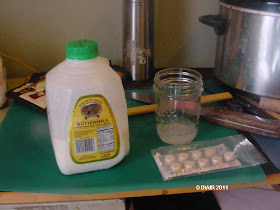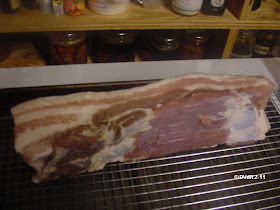These recipes are for cured salmon, and actually I don't have salmon, but a close relative, the steelhead trout. The recipes will work equally well for it. Both are easy to "cure" in the refrigerator in 2-3 days, offering up some lovely alternative taste treats during the dreary winter. Think gravlax, or Nova Scotia; bagels, lox and cream cheese; antipasto/canapes for a party, or just thin-sliced salmon with cream cheese on a good pumpernickel bread sandwich.
The first recipe is fennel-cured, and the second one is a citrus cure. My fish weighed just about two pounds so I divided it into 2 pieces of 1 pound each, because I want to try both cures.
1 pound salmon (or steelhead trout)
46 grams sugar
70 grams light brown sugar
65 grams kosher salt
1/8 cup Pernod (I could only find Ouzo at our state liquor store)
1 fennel bulb with ferns
25 grams toasted fennel seeds
1 tablespoon ground white pepper |
| Before toasting |
 | |
This is twice the fennel seeds for the recipe, done before I decided to do half in a citrus cure |
 |
| After toasting |
Toast the fennel seeds in a hot skillet until fragrant and slightly browned.
Mix the sugars, salt and pepper together well. Put 1/3 down in the bottom of a dish.
Turn the fillet flesh side up and pour the remaining Pernod over it. Add the remaining cure.
Slice the fennel bulb and the ferns, and place on top of the cure.
Sprinkle the fennel seeds on top of the fennel.
Cover with plastic wrap, and find a weight of several pounds that will fit inside the dish with the fish. Here I've used a loaf pan and a 6 pound brick wrapped in a clean plastic food bag.
Refrigerate. I turned them about twice a day to evenly distribute the cure. After 2 days (maybe 3 if the fish is thick), the fish should feel firm and you can rinse the cure off the fish in cold running water. Pat it dry, and you can slice it thinly to eat now, or freeze it for later.
Here's the citrus cure for 1 pound of salmon or trout:
1 pound salmon or steelhead trout
1/2 cup sugar (use brown sugar for a deeper flavored taste)
3.5 oz. kosher salt
zest of one orange
zest of one lemon
Pretty simple! Mix all the ingredients together, add them to a baggie along with the fish (or wrap them in 2-3 layers of plastic wrap and put in a bowl to catch the juices), and refrigerate under some weight. Turn them about twice a day to evenly distribute the cure. After 2 days (maybe 3 if the fish is thick), the fish should feel firm and you can rinse the cure off the fish in cold running water. Pat it dry, and now you can slice it thinly to eat, or freeze it for later.
Here's the piece cured with fennel, after the cure was rinsed off. I put all the pieces in the freezer for a day or two, partly because I'm busy with other projects.
I sliced a bit this morning, and the taste isn't as strong after soaking 2-3 hours, and freezing for a couple of days. There is, however, a faint "fishy" smell, which means it wasn't really fresh when I bought it. One of the problems with not having a fishmonger in my small town is that I cannot ask to smell a fish before purchasing it. Supermarkets do not take kindly to me poking a finger through the plastic-wrap to get a whiff!
I'm prepping the cold smoker now, to give it all a light smoke. I think I will make a smoked fish spread/dip with some of it, and some smoked trout rillettes.
Here's the fish after cold-smiking in maple and apple wood for 8 hours.
Here's the piece cured with fennel, after the cure was rinsed off. I put all the pieces in the freezer for a day or two, partly because I'm busy with other projects.
I sliced a bit this morning, and the taste isn't as strong after soaking 2-3 hours, and freezing for a couple of days. There is, however, a faint "fishy" smell, which means it wasn't really fresh when I bought it. One of the problems with not having a fishmonger in my small town is that I cannot ask to smell a fish before purchasing it. Supermarkets do not take kindly to me poking a finger through the plastic-wrap to get a whiff!
I'm prepping the cold smoker now, to give it all a light smoke. I think I will make a smoked fish spread/dip with some of it, and some smoked trout rillettes.
Here's the fish after cold-smiking in maple and apple wood for 8 hours.




















































